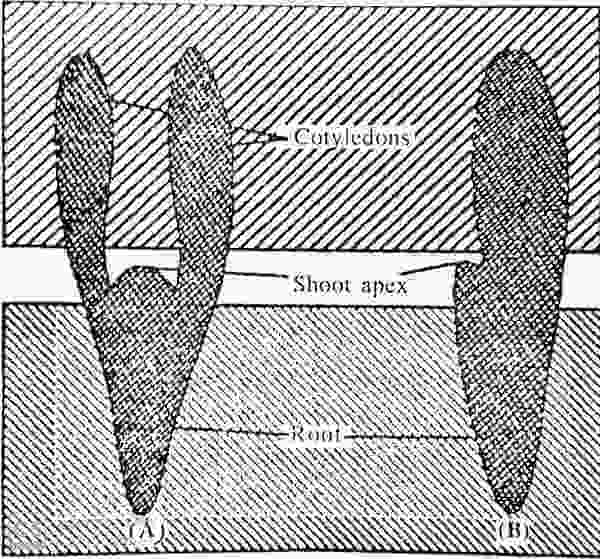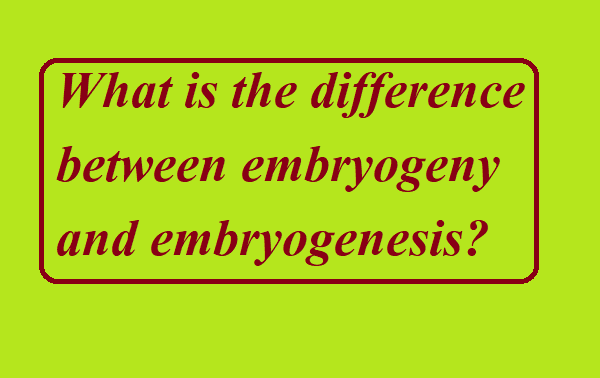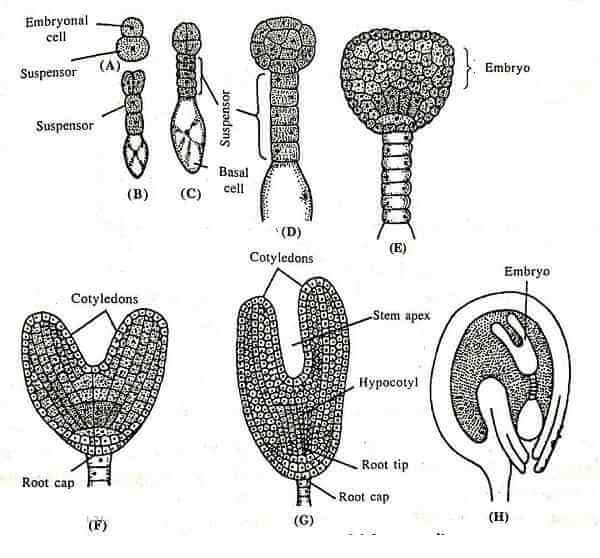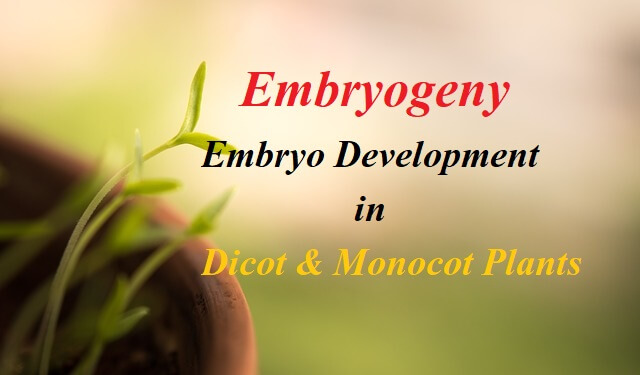Embryo Development in Plants is also called Embryogeny. Embryogeny is the study of embryo development stages. Here we are going to discuss Embryogeny in Dicotyledons and Monocotyledons & Polyembryony in detailed information with the help of Diagrams and examples. Embryogeny is always an important topic for those students who are studying in science stream with botany subject.
What is Embryogeny? ( Embryo Development in Plants)
Embryogenesis or Embryogeny is the study of the subsequent period of development in which the zygote undergoes a complex series of cellular and morphological changes. After these changes, the embryo is converted into a diploid multicellular eukaryotic organism or whole plan /Animal/organism.
What is Embryo? (Embryo Development in Plants)
After fertilization between the male and the female gametes embryo develops. The embryo is a very early stage of development of any organism. After development, the embryo is converted into a diploid multicellular eukaryotic organism. The embryo develops from a diploid cell which is known as a zygote.

Difference between Embryogenesis and Embryology
Embryo Development in Plants
Embryology is the study of embryo development from the fertilization to the foetus stage whereas Embryogenesis is the study of the process of Embryonic development by which the embryo forms and develops. Embryogenesis is the study of the process of development of a mature embryo from the diploid zygote. Embryology refers to the origin, growth and development of an embryo.
Embryology is a branch of Biology whereas embryogenesis is the part of embryology.
What is the difference between embryogenic and embryogenesis? (Embryo Development in Plants)
Embryo Development in Plants

There is no big difference between Embryogeney and embryogenesis. The prefix embryo is the same in both of the terms but the suffix is different in both cases. The suffix “geny” is generally used for the study of the origin of something whereas the suffix “genesis” is used for the study of the mode with which something is developed. Basically, both of the terms are same.
Embryogenesis or Embryogeny is the study of the subsequent period of development in which the zygote undergoes a complex series of cellular and morphological changes. These changes resulting in the formation of a developmentally arrested mature embryo. The embryo comprised of an embryonic Axis with the shoot and root poles and cotyledons. Shoot poles, root poles and cotyledons contain a high level of macromolecules such as protein and lipids as storage.
Read Also – Plant Diseases: Symptoms, Types, Controls | DC
Embryo Development in Monocotyledons Plants
Embryo Development in Plants
Development of embryo in monocotyledons (Embryogeny of monocot plant)
Sagittaria sagittifolia is the monocot plant which is used to study the development of the embryo in monocotyledons. Up to the globular stage, the development of dicot and monocot embryo is similar. The difference in the development of the embryo in monocotyledons and dicotyledons starts after the globular stage.
There is only one terminal cotyledon and the second cotyledon is absent or reduced. The one terminal cotyledon is called scutellum. Another second cotyledon is generally absent but in the case of grasses, the second cotyledon is reduced. Reduced cotyledon is called epiblast.

The basal cell (cb) divides by a transverse wall that produces two cells (ci, m). From this is produced two cell one cell (ci) divided into two cells (n,n). Another cell which was produced from the basal cell divided into two cells transversely. These two cells (n, n) develops into suspensor and root cap. The cell M is also contributed to the remaining part of the root cap and the part of the radical.
The Terminal cell forms a quadrant structure by two vertical walls at right angles to one another. Quadrant sales divided periclinally. Quadrant cells differentiate into the peripheral cells and the inner group of cells. The two regions form after the repeated divisions in both peripheral and Central group of cells. The lower part of cotyledons formed by reason I. I and reason I” I form the upper part of cotyledon hypocotyl and plumule.
Embryo Development in Dichotyledons Plants
Embryo Development in Plants
Development of embryo in dicotyledons (embryogeny in Dicot plant)
The embryo is developed from zygote after a period of rest. Embryogeny of Dicot plants has been studied in Capsella bursapastoris. Capsella bursapastoris belongs to the family Cruciferae.
Zygote divided into two cells transversely. These two cells are basal cell and terminal cell. zygote produces the basal cell towards micropyle and terminal cell towards the Chalaza. Here we are indicating basal cell with (cb) terminal cell with (ca). The proembryo (4 celled stages) is produced by the basal cell and terminal cell. Divided by transfer division and terminal cell divided by longitudinal division.
The two basal cells divided by transversely and form suspensor cells of suspensor is called vesicular and lowest cell is called hypothesis.

16 celled globular embryo is produced from the apical cell. Ethical cells first divide by longitudinal division and then by transversely and periclinal division. The globular embryo becomes heart-shaped due to the differentiation of cotyledons.
Read Also
- 12 Major Difference between Self-Pollination and Cross-Pollination
- Pollination: Definition, Types, Agents & Process
- Reproduction in Flowering plants: Types, Process and Examples
Embryo Development in Plants: Polyembryony
Polyembryony- As name suggests “poly” means multiple and “embryony” means embryo. Polyembryony is the occurrence of more than two embryo in a seed. polyembryony was discovered by A V Leeuwenhock in 1719 in the citrus plant.
Types of Polyembryony
Polyembryony is mainly of four types
1. Simple polyembryony-
Simple polyembryony is due to the presence of more than one embryo sac. Because of more than one embryo sac, more than one use for an egg also found.
Example- brassica
2. Mixed polyembryony-
Mixed Polyembryony is the condition in which more than one Pollen tube entering an ovule and fertilizing synergids and antipodal cell.
Example- Fertilization of synergids bi more than one Pollen tube found in Argemone maxicana and fertilization of antipodals cell by more than one Pollen tube found in Ulmus americana.
3. Cleavage polyembryony
zygote plays the main role in cleavage polyembryony. Cleavage polyembryony occurs due to cleavage of zygote or proembryo into two or more embryos. Each split part develops into an embryo that’s why more than one embryo occurs. Cleavage polyembryony is the common gymnosperms then in angiosperms.
Example- Erythronium americanum, Crtolaria, Nymphaea advena are some examples of cleavage polyembryony.
4. Adventive polyembryony
This is the situation when deployed nucellus or integument cells from embryos occurs.
Examples- Citrus, Mangifera, Opuntia for some examples of adventive polyembryony.
What is True Polyembryony & False polyembryony?
True polyembryony is the condition when extra embryos develop from same embryo sac and False polyembryony is the situation when extra embryos develop elsewhere other than from embryo sac. an extra embryo develops from endosperm in Balenofora.
Here we have discussed “Embryo Development in Plants: Embryogenesis in Plants | Embryogeny” we hope you like this article. if you have any query or suggestion, please leave a comment on the email. or contact us from contact us page.
Follow our official groups on Telegram, Whatsapp and Facebook


